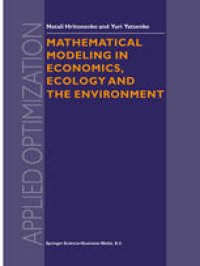
Ebook: Mathematical Modeling in Economics, Ecology and the Environment
- Tags: Mathematical Modeling and Industrial Mathematics, Calculus of Variations and Optimal Control, Optimization, Systems Theory Control, Economic Theory, Ecology
- Series: Applied Optimization 34
- Year: 1999
- Publisher: Springer US
- Edition: 1
- Language: English
- pdf
The problems of interrelation between human economics and natural environment include scientific, technical, economic, demographic, social, political and other aspects that are studied by scientists of many specialities. One of the important aspects in scientific study of environmental and ecological problems is the development of mathematical and computer tools for rational management of economics and environment. This book introduces a wide range of mathematical models in economics, ecology and environmental sciences to a general mathematical audience with no in-depth experience in this specific area. Areas covered are: controlled economic growth and technological development, world dynamics, environmental impact, resource extraction, air and water pollution propagation, ecological population dynamics and exploitation. A variety of known models are considered, from classical ones (Cobb Douglass production function, Leontief input-output analysis, Solow models of economic dynamics, Verhulst-Pearl and Lotka-Volterra models of population dynamics, and others) to the models of world dynamics and the models of water contamination propagation used after Chemobyl nuclear catastrophe. Special attention is given to modelling of hierarchical regional economic-ecological interaction and technological change in the context of environmental impact. Xlll XIV Construction of Mathematical Models ...
The book covers a wide range of known models, from classical (Cobb-Douglass production function, Leontief input-output analysis, Verhulst-Pearl and Lotka-Volterra models of population dynamics, etc.) to the models of world dynamics and the models of water contamination propagation after the Chernobyl nuclear catastrophe. It uses a unique block-by-block approach to model analysis, which explains how all these models are constructed from common simple components (blocks) that describe elementary physical processes. The book provides theoretical insights to guide the design of practical models.
Special attention is given to modeling of hierarchical regional economic-ecological interaction and technological change in the context of environmental impact. Mathematical topics considered include discrete and continuous models, differential and integral equations, optimization and bifurcation analysis, and related subjects. The book presents a self-contained introduction for those approaching the subject for the first time. It provides excellent material for graduate courses in mathematical modeling.
Audience: Researchers, graduate and postgraduate students, and a wide mathematical audience.
The book covers a wide range of known models, from classical (Cobb-Douglass production function, Leontief input-output analysis, Verhulst-Pearl and Lotka-Volterra models of population dynamics, etc.) to the models of world dynamics and the models of water contamination propagation after the Chernobyl nuclear catastrophe. It uses a unique block-by-block approach to model analysis, which explains how all these models are constructed from common simple components (blocks) that describe elementary physical processes. The book provides theoretical insights to guide the design of practical models.
Special attention is given to modeling of hierarchical regional economic-ecological interaction and technological change in the context of environmental impact. Mathematical topics considered include discrete and continuous models, differential and integral equations, optimization and bifurcation analysis, and related subjects. The book presents a self-contained introduction for those approaching the subject for the first time. It provides excellent material for graduate courses in mathematical modeling.
Audience: Researchers, graduate and postgraduate students, and a wide mathematical audience.
Content:
Front Matter....Pages i-xx
Principles of Model Construction....Pages 1-22
Front Matter....Pages 23-26
Aggregate Models of Economic Dynamics....Pages 27-40
Modeling of Technological Change....Pages 41-52
Multi-Sector Linear Economic Models....Pages 53-62
Models of Controlled Technological Renovation....Pages 63-72
Optimization Models of Economic Renovation....Pages 73-86
Front Matter....Pages 87-89
Mathematical Models of Biological Communities....Pages 91-108
Models of Air Pollution Propagation....Pages 109-118
Models of Water Pollution Propagation....Pages 119-136
Front Matter....Pages 137-140
Modeling of Environmental Impact and Resource Extraction....Pages 141-150
Models of World Dynamics: Structure And Results....Pages 151-160
Models for Pollution Propagation Control in Air and Water....Pages 161-170
Environmental Impact in Models of Technological Renovation....Pages 171-180
Economic Control of Ecological Populations....Pages 181-190
Back Matter....Pages 191-210
The book covers a wide range of known models, from classical (Cobb-Douglass production function, Leontief input-output analysis, Verhulst-Pearl and Lotka-Volterra models of population dynamics, etc.) to the models of world dynamics and the models of water contamination propagation after the Chernobyl nuclear catastrophe. It uses a unique block-by-block approach to model analysis, which explains how all these models are constructed from common simple components (blocks) that describe elementary physical processes. The book provides theoretical insights to guide the design of practical models.
Special attention is given to modeling of hierarchical regional economic-ecological interaction and technological change in the context of environmental impact. Mathematical topics considered include discrete and continuous models, differential and integral equations, optimization and bifurcation analysis, and related subjects. The book presents a self-contained introduction for those approaching the subject for the first time. It provides excellent material for graduate courses in mathematical modeling.
Audience: Researchers, graduate and postgraduate students, and a wide mathematical audience.
Content:
Front Matter....Pages i-xx
Principles of Model Construction....Pages 1-22
Front Matter....Pages 23-26
Aggregate Models of Economic Dynamics....Pages 27-40
Modeling of Technological Change....Pages 41-52
Multi-Sector Linear Economic Models....Pages 53-62
Models of Controlled Technological Renovation....Pages 63-72
Optimization Models of Economic Renovation....Pages 73-86
Front Matter....Pages 87-89
Mathematical Models of Biological Communities....Pages 91-108
Models of Air Pollution Propagation....Pages 109-118
Models of Water Pollution Propagation....Pages 119-136
Front Matter....Pages 137-140
Modeling of Environmental Impact and Resource Extraction....Pages 141-150
Models of World Dynamics: Structure And Results....Pages 151-160
Models for Pollution Propagation Control in Air and Water....Pages 161-170
Environmental Impact in Models of Technological Renovation....Pages 171-180
Economic Control of Ecological Populations....Pages 181-190
Back Matter....Pages 191-210
....